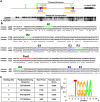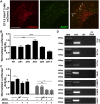Rbpj direct regulation of Atoh7 transcription in the embryonic mouse retina
- PMID: 29977079
- PMCID: PMC6033939
- DOI: 10.1038/s41598-018-28420-y
Rbpj direct regulation of Atoh7 transcription in the embryonic mouse retina
Abstract
In vertebrate retinal progenitor cells, the proneural factor Atoh7 exhibits a dynamic tissue and cellular expression pattern. Although the resulting Atoh7 retinal lineage contains all seven major cell types, only retinal ganglion cells require Atoh7 for proper differentiation. Such specificity necessitates complex regulation of Atoh7 transcription during retina development. The Notch signaling pathway is an evolutionarily conserved suppressor of proneural bHLH factor expression. Previous in vivo mouse genetic studies established the cell autonomous suppression of Atoh7 transcription by Notch1, Rbpj and Hes1. Here we identify four CSL binding sites within the Atoh7 proximal regulatory region and demonstrate Rbpj protein interaction at these sequences by in vitro electromobility shift, calorimetry and luciferase assays and, in vivo via colocalization and chromatin immunoprecipitation. We found that Rbpj simultaneously represses Atoh7 transcription using both Notch-dependent and -independent pathways.
Conflict of interest statement
The authors declare no competing interests.
Figures






Similar articles
-
Notch signaling differentially regulates Atoh7 and Neurog2 in the distal mouse retina.Development. 2014 Aug;141(16):3243-54. doi: 10.1242/dev.106245. Development. 2014. PMID: 25100656 Free PMC article.
-
Rbpj cell autonomous regulation of retinal ganglion cell and cone photoreceptor fates in the mouse retina.J Neurosci. 2009 Oct 14;29(41):12865-77. doi: 10.1523/JNEUROSCI.3382-09.2009. J Neurosci. 2009. PMID: 19828801 Free PMC article.
-
Reprogramming amacrine and photoreceptor progenitors into retinal ganglion cells by replacing Neurod1 with Atoh7.Development. 2013 Feb 1;140(3):541-51. doi: 10.1242/dev.085886. Development. 2013. PMID: 23293286 Free PMC article.
-
Transcription Factor RBPJ as a Molecular Switch in Regulating the Notch Response.Adv Exp Med Biol. 2021;1287:9-30. doi: 10.1007/978-3-030-55031-8_2. Adv Exp Med Biol. 2021. PMID: 33034023 Review.
-
Role of CSL-dependent and independent Notch signaling pathways in cell apoptosis.Apoptosis. 2016 Jan;21(1):1-12. doi: 10.1007/s10495-015-1188-z. Apoptosis. 2016. PMID: 26496776 Review.
Cited by
-
The Atoh7 remote enhancer provides transcriptional robustness during retinal ganglion cell development.Proc Natl Acad Sci U S A. 2020 Sep 1;117(35):21690-21700. doi: 10.1073/pnas.2006888117. Epub 2020 Aug 17. Proc Natl Acad Sci U S A. 2020. PMID: 32817515 Free PMC article.
-
New Insights Into the Intricacies of Proneural Gene Regulation in the Embryonic and Adult Cerebral Cortex.Front Mol Neurosci. 2021 Feb 15;14:642016. doi: 10.3389/fnmol.2021.642016. eCollection 2021. Front Mol Neurosci. 2021. PMID: 33658912 Free PMC article. Review.
-
Key transcription factors influence the epigenetic landscape to regulate retinal cell differentiation.Nucleic Acids Res. 2023 Mar 21;51(5):2151-2176. doi: 10.1093/nar/gkad026. Nucleic Acids Res. 2023. PMID: 36715342 Free PMC article.
-
Dynamic Polarization of Rab11a Modulates Crb2a Localization and Impacts Signaling to Regulate Retinal Neurogenesis.Front Cell Dev Biol. 2021 Feb 9;8:608112. doi: 10.3389/fcell.2020.608112. eCollection 2020. Front Cell Dev Biol. 2021. PMID: 33634099 Free PMC article.
-
Notch pathway mutants do not equivalently perturb mouse embryonic retinal development.PLoS Genet. 2023 Sep 26;19(9):e1010928. doi: 10.1371/journal.pgen.1010928. eCollection 2023 Sep. PLoS Genet. 2023. PMID: 37751417 Free PMC article.
References
-
- Brown NL, et al. Math5 encodes a murine basic helix-loop-helix transcription factor expressed during early stages of retinal neurogenesis. Development. 1998;125:4821–4833. - PubMed
Publication types
MeSH terms
Substances
Grants and funding
LinkOut - more resources
Full Text Sources
Other Literature Sources
Molecular Biology Databases

